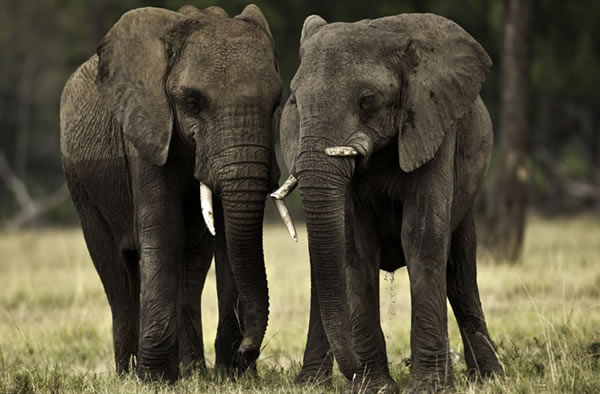Africa 'Hemmorhaging Elephants' at Record Rate
Africa 'Hemmorhaging Elephants' at Record Rate
Central Africa is “hemorrhaging elephants at an unprecedented scale” primarily due to poaching, a new study finds.
A staggering 62 percent of all forest elephants have been killed for their ivory over the past decade, according to the research.
The report, published today in the journal PLoS ONE, is the first range-wide, data-driven study to confirm what conservationists had already suspected, given so many massacres and individual deaths of these majestic animals in recent months.
The study was the largest ever conducted on the African forest elephant and includes the work of more than 60 scientists between 2002 and 2011, and an immense effort by national conservation staff who spent 91,600 person-days surveying for elephants in five countries (Cameroon, Central African Republic, the Democratic Republic of Congo, Gabon and the Republic of Congo), walking more than 8,000 miles and recording over 11,000 samples for the analysis.
The study’s release coincides with the CITES (Convention on the International Trade in Endangered Species) meeting being held in Bangkok until March 14.
Boo Maisels of the World Conservation Society led the research. WCS spokesperson Stephen Sautner shared these findings from the study with Discovery News:
· A rapid trend towards extinction is expected — potentially within the next decade — of the forest elephant, according to the authors.
· Almost a third of the land where African forest elephants were able to live 10 years ago has become too dangerous for them.
· Forest elephants were increasingly uncommon in places with high human density, high infrastructure density such as roads, high hunting intensity, and poor governance as indicated by levels of corruption and absence of law enforcement.
· Research carried out by the CITES-MIKE program has shown that the increase in poaching levels across Africa since 2006 is strongly correlated with trends in consumer demand in the Far East, and that poaching levels are also strongly linked with governance at the national level and poverty at the local scale. This has resulted in escalating elephant massacres in areas previously thought to be safe.
Effective, rapid, multi-level action is imperative to save elephants. A drastic increase of funding, and an immediate focus on the most effective protection strategies, are essential to avoid future huge losses to the remaining elephant populations.
Reducing chronic corruption and improving poor law enforcement, which facilitate poaching and trade, are crucial. It is also vital to improve control of import and sales of wildlife goods by the recipient and transit countries of illegal ivory, especially in Asia. The recipient nations, with the international community, should invest heavily in public education and outreach to inform consumers of the ramifications of the ivory trade.
“The global poaching crisis for elephants is at epidemic proportions,” WCS Executive Vice President for Conservation and Science John Robinson concluded. “The world must come together to recognize this problem and to stop the killing, trafficking, and demand, or we will lose elephants in the wild in our lifetime.”
Mar 4, 2013 05:00 PM ET by Jennifer Viegas












